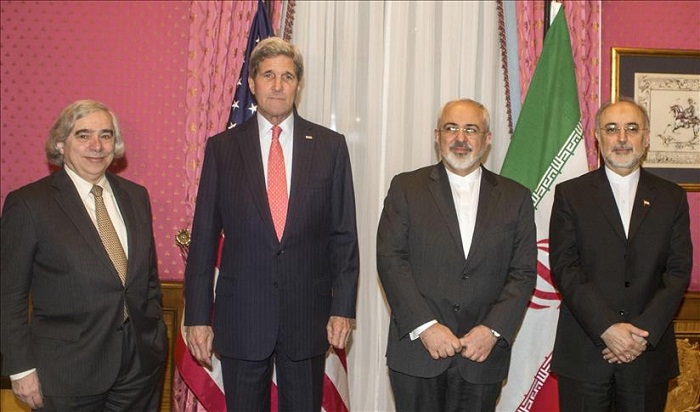The Danger of a Failed Iran Deal

Today, there are many who are prepared to reject a negotiated nuclear agreement with Iran on the grounds that a return to coercive pressure and isolation will ensure the elimination of the entire Iranian nuclear capability and extend that “zero probability” of a nuclear weapon into the indefinite future. This is close to the position that Israeli Prime Minister Benjamin Netanyahu laid out in his speech to Congress last week.
Certainly, turning back the clock and eliminating every aspect of nuclear know-how in Iran would be desirable. But proponents of an even more coercive policy should recognize that if they get their wish, they may create a security threat far greater than the limited threat they are now trying to prevent.
We don’t need a fortuneteller or crystal ball to predict the outcome of such a policy. We have more than three decades of experience to draw upon, based on the policies of eight successive American presidents and four presidents of Iran. Over that period of time, Iran has been subjected to a wide variety of sanctions and pressures. Originally these were mostly unilateral pressures from the U.S., but under the Obama administration they have become far more international and far-reaching, culminating in the crippling sanctions on Iran’s oil sales and its ability to access international financial markets.
Twice, Iran has come to the negotiating table. The first time was in 2003-05, when the Iranian negotiating team of Hassan Rohani and Javad Zarif — not yet president and foreign minister — made a proposal to cap Iran’s centrifuges at about 3,000. The United States was not a direct participant in those talks with several European states, but it is widely acknowledged that the George W. Bush administration vetoed the talks for essentially the same reason as opponents of the present negotiations. It was believed that the danger of permitting Iran to operate several thousand centrifuges was too great. Moreover, the coercive pressures available to the United States and the international community had scarcely been tried, and sanctions had not really begun to bite.
We all know what happened. With sanctions increasing almost by the day, and with increasing threats of a unilateral attack by Israel (which would probably draw in the U.S. and others), Iran steadily increased its nuclear program. By the time Rohani and Zarif returned to the field in 2013, Iran had about 20,000 centrifuges installed in two major sites — one of them deep underground — and a substantial stockpile of enriched uranium. Some of the uranium was enriched to nearly 20 percent, which is well on the way to weapons level.
That situation was so alarming that Netanyahu appeared before the United Nations General Assembly displaying a cartoon drawing that showed a bomb filling with 20 percent enriched uranium. He estimated that it would arrive at the red line — enough to produce a bomb’s worth of highly enriched uranium very quickly — by the following summer. Many close observers of Israel believed that an attack on Iran’s nuclear infrastructure was imminent.
Netanyahu, in various capacities, had been warning of an imminent Iranian nuclear weapon since at least 1992, when he told the Israeli Knesset that Iran could have a bomb in three to five years. He and others, in Israel and elsewhere, have made similar predictions almost annually for the past two decades.
It is easy to dismiss these predictions as fear-mongering about something that obviously never happened. But it is much more instructive to understand that what they were saying had a basis in fact: During this entire period, Iran was steadily increasing its capability to produce a nuclear bomb. The more interesting fact is that Tehran did not follow through. By virtually every estimate, Iran has had the capability to produce a nuclear weapon for at least a decade. The predictions were wrong, not about Iran’s ability but about its willingness to use that capability to produce a weapon. The entire U.S. intelligence community and most of our allies — apparently including Israel — have concluded with high confidence that Iran has not made a decision to build a bomb.
The second round of multilateral negotiations with Iran is approaching the finish line. The details have not been announced, but the outlines of an agreement seem to be emerging. Netanyahu’s cartoon bomb has been drained. It is now empty of 20 percent enriched uranium, and all indications point to the fact that Iran’s stockpile of enriched uranium will be severely limited for the foreseeable future. Iran is the world’s most inspected state. It has apparently agreed to accept vigorous international inspection in perpetuity in return for an agreement that lifts the most onerous sanctions on its commerce. Iran has ceased development of its heavy water reactor at Arak, which produces plutonium — the shortest route to weapons-quality fissile material — and will modify it permanently. And the most severe restrictions ever imposed on a state will reportedly be accepted for a decade or more before Iran is gradually permitted to assume its position as a “normal” member of the Nuclear Non-Proliferation Treaty, which explicitly prohibits Iran from acquiring nuclear weapons.
On the other hand, if this agreement is rejected, as the Israeli prime minister and many in Congress are proposing, we go back to the early days of 2013: heavy sanctions, a rapidly increasing Iranian nuclear program and a looming threat of war. That is surely something no responsible statesman or politician would wish to see.















































